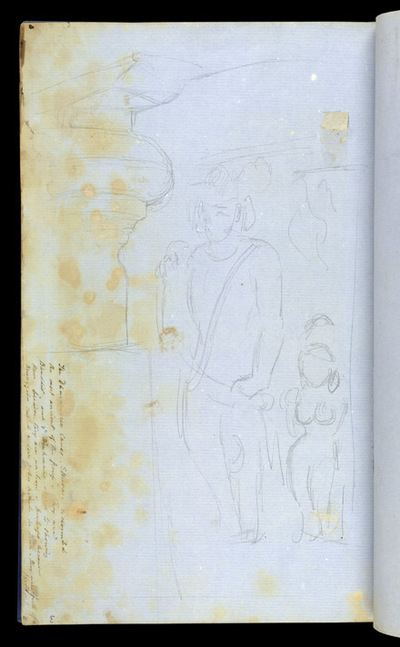Javascript must be enabled to continue!
f.3 Cave 5, Ellora. 'The Dhurwaree Caves.'
View through Europeana Collections
Pencil and wash drawing of sculptures in the Dher
Warra Cave at Ellora, from an Album of 83 drawings; 80 of
landscapes and antiquities in the northem Deccan, 2 portraits and 1
flower study made during a tour chiefly to Ellora, Rauza,
Daulatabad, Aurangabad and Ajanta. September to November 1849.
Although the artist is unidentified, these drawings are of some
interest since they show the state of the Ajanta and Ellora Caves
soon after the Royal Asiatic Society had brought them to the
Company's notice in 1844. Robert Gill had been deputed to make a
record of Ajanta in 1846 and was presumably on the spot when these
sketches were made.The spectacular site of Ellora, in Maharashtra,
is famous for its series of Buddhist,Hindu and Jain cave temples
excavated into the rocky façade of a cliff of basalt. Theworks
were done under the patronage of the Kalachuri, the Chalukya and
the Rashtrakuta dynasties between the sixth and the ninth
centuries. Dher Warra is a single-storey excavation in the
southernmost group of the Buddhist caves which dates back to the
6th century. It consists of a long spacious hall or vihara which
was used as a Buddhist monastery as it is indicated by the
residential cells cut into the side walls. The two long lines of
benches carved out of the floor were probably intended for the use
of the monks when studying or dining. The hall is divided into
three aisles by two rows of columns. This drawing depicts some
figures carved in the cave.
Title: f.3 Cave 5, Ellora. 'The Dhurwaree Caves.'
Description:
Pencil and wash drawing of sculptures in the Dher
Warra Cave at Ellora, from an Album of 83 drawings; 80 of
landscapes and antiquities in the northem Deccan, 2 portraits and 1
flower study made during a tour chiefly to Ellora, Rauza,
Daulatabad, Aurangabad and Ajanta.
September to November 1849.
Although the artist is unidentified, these drawings are of some
interest since they show the state of the Ajanta and Ellora Caves
soon after the Royal Asiatic Society had brought them to the
Company's notice in 1844.
Robert Gill had been deputed to make a
record of Ajanta in 1846 and was presumably on the spot when these
sketches were made.
The spectacular site of Ellora, in Maharashtra,
is famous for its series of Buddhist,Hindu and Jain cave temples
excavated into the rocky façade of a cliff of basalt.
Theworks
were done under the patronage of the Kalachuri, the Chalukya and
the Rashtrakuta dynasties between the sixth and the ninth
centuries.
Dher Warra is a single-storey excavation in the
southernmost group of the Buddhist caves which dates back to the
6th century.
It consists of a long spacious hall or vihara which
was used as a Buddhist monastery as it is indicated by the
residential cells cut into the side walls.
The two long lines of
benches carved out of the floor were probably intended for the use
of the monks when studying or dining.
The hall is divided into
three aisles by two rows of columns.
This drawing depicts some
figures carved in the cave.
Related Results
f.25 Dumar Lena Cave with sculpture of Ravana rocking Mount
Kailasa, Cave 29, Ellora. 'Entrance to Dhurma Lena. Septr.
25.'
f.25 Dumar Lena Cave with sculpture of Ravana rocking Mount
Kailasa, Cave 29, Ellora. 'Entrance to Dhurma Lena. Septr.
25.'
Wash and watercolour drawing of the sculpture of
Ravana shaking Mount Kailasa from Dhumar Lena, Cave 29 at Ellora,
from an Album of 83 drawings; 80 of landscapes and antiquities in...
f.28 Entrance to Dumar Lena Cave with sculpture of Siva's
Dance in the Elephant Skin, Cave 29, Ellora. 'Dhurma Lena. 26
Sept.'
f.28 Entrance to Dumar Lena Cave with sculpture of Siva's
Dance in the Elephant Skin, Cave 29, Ellora. 'Dhurma Lena. 26
Sept.'
Wash and watercolour drawing of the Dhumar Lena,
Cave 29 at Ellora, from an Album of 83 drawings; 80 of landscapes
and antiquities in the northem Deccan, 2 portraits and 1 flower
s...
Inscribed on reverse: 'Tin Tal Cave Ellora. March
1847'
Inscribed on reverse: 'Tin Tal Cave Ellora. March
1847'
Water-colour by Charles Power Cobbe of the Tin
Tal Cave at Ellora, dated March 1847. Inscribed on reverse: 'Tin
Tal Cave Ellora. March 1847 CPC'.Charles Power Cobbe was in the 8th
...
Cave 1, Details of Pillars f.33
Cave 1, Details of Pillars f.33
Pencil drawing of pillars and pilasters from Cave
1 at Ajanta, from an Album of 26 ground plans of the Ajanta caves
and 16 folios of drawings of sculpture and architectural details...
Cave 1, Details of Pillars f.34
Cave 1, Details of Pillars f.34
Pencil drawing of pillars from Cave 1 at Ajanta,
from an Album of 26 ground plans of the Ajanta caves and 16 folios
of drawings of sculpture and architectural details in the Ajanta...
Cave 1, Details of Pillars f.30
Cave 1, Details of Pillars f.30
Pencil drawing of pillars from Cave 1 at Ajanta,
from an Album of 26 ground plans of the Ajanta caves and 16 folios
of drawings of sculpture and architectural details in the Ajanta...
Cave 2, Sculptures in Subsidiary Shrines
Cave 2, Sculptures in Subsidiary Shrines
Pencil drawing of the sculptures in one of the
subsidiary shrine of Cave 2 at Ajanta, from an Album of 26 ground
plans of the Ajanta caves and 16 folios of drawings of sculpture
an...
Cave 2, Entrance to Cell at Right Hand End of Porch
Cave 2, Entrance to Cell at Right Hand End of Porch
Pencil drawing of the entrance to the cell at the
right hand end of the porch of Cave 2 at Ajanta, from an Album of
26 ground plans of the Ajanta caves and 16 folios of drawings of...




